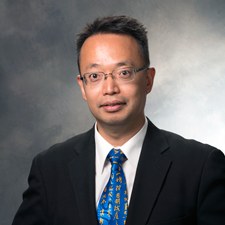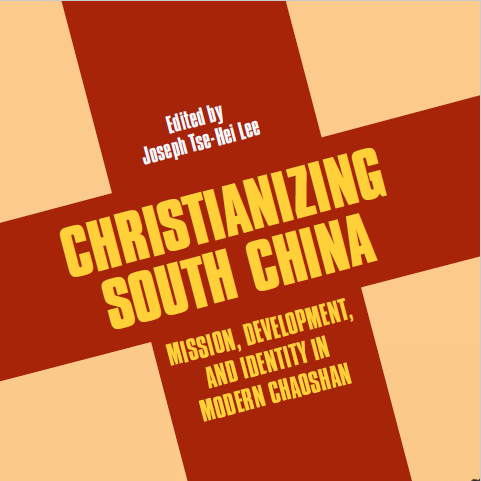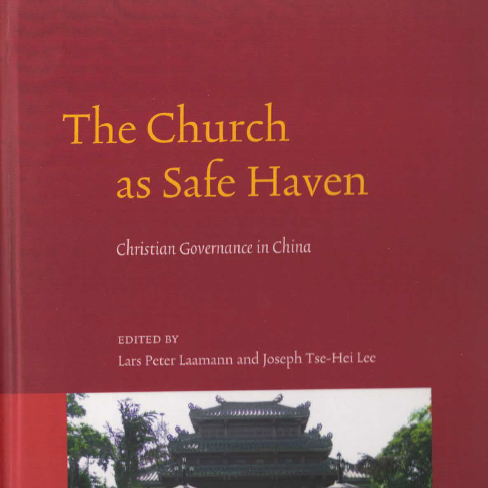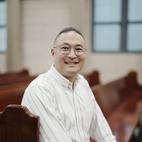Editor's note: Fascinated by history, Professor Joseph T.H. Lee, originally born in Hong Kong and now residing in the United States, started his interest in the history of Christianity in China with his Christian family heritage. Exploring how collective violence influenced the mission in South China, the church history professor set off his intellectual journey to discover how Christianity took root in China and found its expression in a transnational context. Meanwhile, he urges the Chinese Church as one part of the global Christian fellowship to apply what it has learned from the past to today's challenges at home and abroad, particularly in the Post-Covid Era.
China Christian Daily: Can you please introduce yourself and your research field?
Professor Joseph T. H. Lee: I am a professor of history and executive director of the Global Asia Institute at Pace University in New York City, US. I am originally from Hong Kong and earned my BA (Hons), MA and PhD from the University of London. My research focuses on the lived experiences of Christian missionaries and faith communities in modern China, and the early development of Christian radio in the Chinese diaspora.
China Christian Daily: Why do you study church history?
Professor Joseph T. H. Lee: History always fascinates me. My interest in the history of Christianity in China has to do with my family history. My paternal grandfather was a village church deacon in Kuxi, one of the largest American [Northern] Baptist congregations in the Chaozhou-Shantou mission field in Guangdong Province. But everything changed in the mid-20th century. In the 1950s, my father left Kuxi to Hong Kong for a better life. Growing up in Hong Kong, I heard stories about my family’s Baptist heritage and am curious about my ancestors’ interactions with foreigners.
When I first visited my father’s ancestral village Kuxi in the 1980s, my relatives’ faith captured my attention. What impressed me most were their displays of Christian decorative arts, paintings, and Biblical verses inside and outside their homes. They were proud of their faith even though they were cut off from American missionaries and overseas Chinese churches for decades.
Many years later, as I prepared for my postgraduate research at the School of Oriental and African Studies (SOAS), University of London, I came across some diplomatic documents about intra-lineage feuds between the Baptist congregation and the Catholic Church in Kuxi in 1896-1897. The Kuxi Baptists were from the junior faction of the Li lineage, whereas the Catholics came from the senior faction. These rival lineage members knew something about the Christian sectarianism as they saw that the American Baptist and French Catholic missions ridiculed and competed with each other around Shantou. The fact that foreigners used separate Chinese terms to refer to Christianity, namely, tianzhujiao (religion of the Lord of Heaven) versus jidujiao (religion of Christ) reinforced a popular impression that Catholicism and Protestantism were two rather different religions, with missionaries from both sides being competitors, if not antagonists. When the rival Li factions turned to the American Baptists and French Catholics for help, they employed the missionary and diplomatic powers in their own resource conflicts. The motives of their conversions might not be honorable, but as time passed, the Baptist and Catholic faiths took roots among the Lis and became part of their kinship identities.
With this incident in mind, I set out to investigate how the frequent outbreaks of collective violence influenced the Christian missionary movements in South China, and the results of my research was published as a book entitled The Bible and the Gun: Christianity in South China, 1860–1900 (New York, 2003), with the Chinese version《圣经与枪炮: 基督教与潮州社会 (1860-1900) 》 (北京 : 社会科学文献出版社, 2010).
I also drew on the rich collections of missionary photographs to produce Context and Horizon: Visualizing Chinese-Western Cultural Encounters in Chaoshan [《处境与视野:潮汕中外交流的光影记忆》] (北京: 三联书店, 2017), a bilingual photographic history of the American Baptist and English Presbyterian missionary activities in South China.
China Christian Daily: Can you share with us your books Christianizing South China: Mission, Development and Identity in Modern Chaoshan and The Church as Safe Haven: Christian Governance in China?
Professor Joseph T. H. Lee: While the current scholarship has stressed the role of native Christians as primary agents in indigenizing the Gospel in China, these two edited books propose to acknowledge the complementary relationship between localizing the Christian faith and maintaining fellowship with the global Church.
Christianizing South China: Mission, Development and Identity in Modern Chaoshan is the fruit of my collaboration with a new generation of Chinese and Western experts on the Church history in Chaozhou-Shantou, an area known for its long history of outward-looking maritime culture. Both foreign missionaries and Chaozhou Christians were good at managing the global-local church ties in this maritime society. This book reassesses the contributions of Protestant missions and churches to institution-building and socio-economic development in the local society. Most interesting in this regard was the development of the modern needlework industry as it emerged from the mission school system. Several female missionaries introduced Western needlework techniques to empower school girls. What was meant to be a sideline occupation for girls became a thriving industry that exported its products transnationally. This surprising outcome contributed to the rural economy and created additional economic opportunities for women.
Along the same line reasoning, The Church as Safe Haven: Christian Governance in China takes a broader thematic perspective than Christianizing South China, and pays tribute to my late mentor, Prof. R. G. Tiedemann (SOAS, University of London). This work paves the way for scholars to contextualize the local Chinese expressions of the Christian faith in a transnational context.
By paying close attention to the relationships constructed between the local believers, missionaries, and their modern institutions, The Church as Safe Haven demonstrates how these local-global Christian forces worked together to build community infrastructures or “safe havens” for ordinary people. The rich historical accounts offer an activist perspective, showing that Chinese Christians inserted their visions and agendas into the indigenous revival movements, mission schools, hospitals, Bible societies, and emergency relief efforts with varying levels of success.
China Christian Daily: In your book The Church as Safe Haven: Christian Governance in China, you elaborate on juxtaposing foreign missionary work with home-grown Protestant independent congregations. Can you explain more about this?
Professor Joseph T. H. Lee: The current academic literature has emphasized the key role of Chinese Christians as key agents in managing Christian enterprises and localizing the Gospel. But one should never overlook the lived experiences of foreign missionaries and Chinese believers in different temporal and spatial settings.
One good example is Joseph W. Ho’s research on the social meaning of old missionary photographs in modern China [Joseph W. Ho, Developing Mission: Photography, Filmmaking, and American Missionaries in Modern China (Ithaca, NY: Cornell University Press, 2022)].
Ho refers to nursing intern Liu Ju and the friendship of her Cornell-educated husband Li Qinghai with their American Presbyterian missionary mentors. The old family photos acknowledged the faithful friendships in Chinese-American cultural exchanges but they caused much stress and anxiety to Liu Ju and Li Qinghai during the 1960s. Only after the normalization of US-China relationships did the old photographs enable everyone to appreciate the modernizing inputs of Christianity. These historical personal encounters had long-lasting transformative effects on individuals, families and churches.
China Christian Daily: What does the history of the Chinese church contribute to the global church?
Professor Joseph T. H. Lee: The Chinese churches should feel proud of their past and their extraordinary accomplishments since the 1950s. Today’s Chinese churches in major cities are cosmopolitan and resourceful, and their leaders are excited about new opportunities for evangelistic growth created by China’s rise.
Meanwhile, the Chinese churches are members of the global Christian fellowship and have much to contribute to the common struggle facing Christians elsewhere. The transnational concern for peace, justice, and equity should give Chinese Christians an opportunity to dialogue and partner with different Christian communities from around the world.
Furthermore, the Chinese churches can draw on valuable insights from the lived experiences of missionaries and believers in the past. This is particularly true for the ministry of healing today. Helping people overcome personal wounds and traumas caused by the COVID-pandemic is a major challenge in China and abroad. Throughout the late 19th and early 20th centuries, the Chinese churches were viable civic institutions; they worked with foreign missions to launch a broad spectrum of social and cultural reform efforts, many of them directed toward those on the margins of society, or what Jesus calls “the least of these.” Therefore, connecting faith with actions is key to the moral vision of Chinese Christianity.
China Christian Daily: What do you think of the academic work of church history conducted in China? Is there any way to promote the cooperation between two sides?
Professor Joseph T. H. Lee: Church history is a very promising field in China. I am impressed by a growing number of M.A. and Ph.D. dissertations, academic monographs, conference proceedings, and journal articles on different aspects of the history of Christianity in China. Before the COVID pandemic, I hosted visiting students from Shandong University who came to the US to conduct archival research. Thanks to social media technologies, online academic cooperation is going to be the new normal in the post-COVID era.
China Christian Daily: Do you have any words for the Chinese church?
Professor Joseph T. H. Lee: The Chinese churches might want to pay closer attention to valuable ethical and pastoral insights from the past. This is particularly helpful for the ministry of healing today. Helping people overcome personal wounds and traumas caused by the COVID-pandemic is a major challenge in China and abroad. Throughout the late 19th and early 20th centuries, the Chinese churches were viable civic institutions; they worked with foreign missions to launch a broad spectrum of social and cultural reform efforts, many of them directed toward those on the margins of society, or what Jesus calls “the least of these.” Therefore, connecting faith with actions is key to the moral vision of Chinese Christianity.
China Christian Daily: Do you expect any help from China to benefit your research work?
Professor Joseph T. H. Lee: First, easy access to the Chinese church archives is vital to historical research. Because most of the archives of the Christian missions and independent churches were confiscated by the government in the 1950s, I hope that today’s Chinese Christian citizens, especially the Three-Self patriotic church leaders, could petition the national, provincial, and municipal authorities to make the official archives easily accessible to international and local scholars for research.
Second, transnational collaboration is essential for better understanding during challenging times. I hope to have more opportunities to collaborate with Chinese churches, seminaries, charities, and media enterprises in conducting public and community history projects.
















